
Dresses for Boys during the Early 20th Century (1900-19)
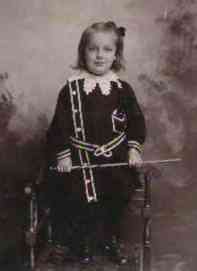
Figure 2.--Dresses in boys' styles appeared in the late 19th Century and were common by the turn of the century. This looks like a boys' dress, but is a real tough one to evaluate. As it is an American (New York) image, the hair bow suggests a girl to me and the hair seems a bit girlish, but does not tell us much. The cane and the pose seems rather.
|
Dresses especially made for boys continued to be popular in the early 1900s. It was still common for younger boys to wear them. Fashion magazines were still advising mothers in the early 1900s that, "petticoats for samall boys are to be recommened in every way ... the putting of infants at an early age into woolen knickerbocker suits cannot but be bad for them physically." There were no hard rules on the dress styles worn by boys. The trend was for boys to wear plainer dresses and for fewer older boys to wear them. This convention was, however rapidly declining in popualrity. It became notably less common in the 1900s anafter World War I (1914-18) it became realtively rare except for infant. The dresses that boys did wear became increasingly plain with less ruffled and lace trim. White desses predominated.
Chronology
Younger boys still wore dresses after the turn of the century in the but by the 1910s it was becoming less common. The dresses that boys did wear were becoming increasingly plain and simple.
The 1900s
Boys still wore dresses in the 1900s. It was not as common as in the 1890s, but was still relatively common. Many of the fashions popular in the 1890s with ruffles and lace trim. Younger boys were still wearing them at the turn of the 20th century. A good example is an American boy with his holde brother about 1905. The popularity of boys wearing dresses declined as the decade progressed.
The custom of dressing yonger boys in dresses declined notably during the 1910s. I am not sure why this occurred in the 1910s. Some have suggested that the development of rubber pants made it less neccessary to keep young boys in dresses. World War I may have also been a factor, but I am not sure yey just how it affected this fashion. The dresses boys did wear were increasingly simple.
Conventions
Actual dresses for boys were still widely worn even after the turn-of-the 20th century, although they were increasingly worn by younger boys. Mail order catalogs and fashion magazines in the early 1900s, for example, offered a wide range of elaborate dress and kilt suits. It was now increasingly common for boys to wear dresses especially styled for them. The authors have many of the same questions about the fashion of outfitting boys in dresses surfaced on this custom in earlier periods. Few details are written on this custom. Did a boy wearing dresses, wear dresses and smocks all the time, or was the dress reserved for formal occasions. It is also not know if a complete wardrobe would be purchased for the boy, or would there be a brief period in which he would still wear his dressed for various occasions until all his dresses were replaced. Although baby boys were outfitted in 'dresses' at the begiining of this century, I don't think the garments were perceived by families as being girlish. They were just garments for baby boys which happened to be made in a (rather practical) dress style. There were no hard rules on the dress styles worn by boys. The trend was for boys to wear plainer dresses and for fewer older boys to wear them. A doting mother could, however, just as easily buy a fancy, lace-trimmed girls dress for her son. Many dresses were children's dresses and not made specifically for either gender. The plainer styles had by the turn of the century become more popular for boys, but many boys with fashion conscious mothers still wore quite frilly dresses.
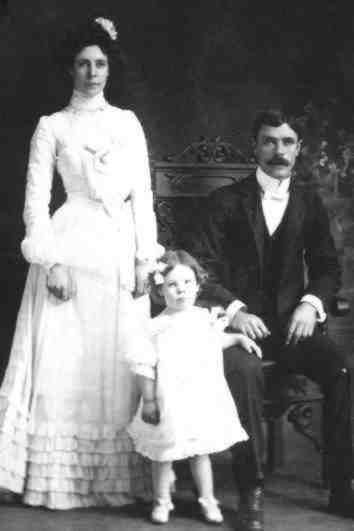
Figure 3.--Little boys still wore dresses in the 1900s, but after the turn of the century it became increasingly unusual to see boys older than about 5 or 6 still wearing dresses. This photograph was taken in 1902.
|
Styles
Some of the features of the dresses especially styled for boys included:
Trim
The specialized boy dresses for boys were generally plainer than those for girls with less lace trim and ruffles.
Collar
Some dresses had lace collars. The ones for girls were often rounded while those for boys might have more of a pattern. This was not a hard and fast rule, but the pattened
collars for boys do seem to have been more common.
Buttons
Buttons were often an important stylistic feature and boys' dresses might be front byuttoning.
Belts
Belts were also commonly used as stylistic elements. Belts were not unknown on girls' dresses, but they were more common on boys' dresses and larger.
Length
Dresses became shorter in the 1900s. Long dresses became increasingly less common. Younger children by the 1910s might wear knee-length dresses.
Color
Boy dresses tended to be in more muted colors than thse for girls.
Pleats
Material
Ribbons and sashes
Many dresses for girls employed ribbons. Younger children might wear ribbon ties at the shoulders, perhaps harkening back to leading strings. Ribbons were less commonly used on dresses for boys, but some mothers did use them, especially for younger boys.
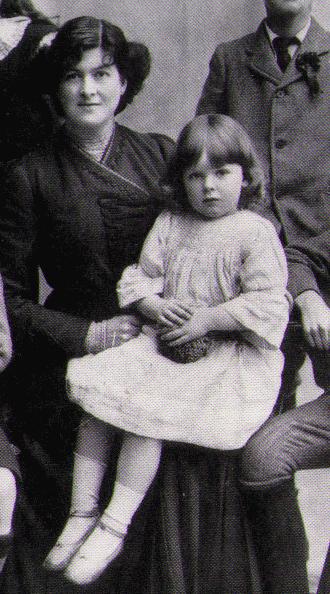
Figure 4.--This upper class English boy was photographed in 1910. He is Stephen Tennant and was 4 years old. The mother, Pamela was born in 1871. Pamela married into Tennants, a very rich Scottish merchant family. She was from a much more gentil (Whyndham) background than the Tennants. She was members of the "Souls" a group of upper class intellectuals. She and her three sisters are the models for John Singer Sargeant's painting "The Three Graces". Stephen was the model for the main character in Nancy Mitford novel, "Love in a Cold Climate". Stephen biographer reports that as a boy he had long blond hair and was dressed by Pamela in fussy dresses until 8. For a view of Stephen's brothers and sisters, click on the image.
|
Style
Styles in the first decade of the 20th century were similar to the 1890s. Even after the turn of the century dresses were available in a great variety of styles, some with elaborate lace, ruffles, and other trim. Lace became increasingly less fashionable as the decade progressesd. Some of the dresses offered would have looked just as nice on a girl as a boy, although gradually plainer styles for boys became more available. Note that some styles have boyish collars, but many appear indistinguishable from styles for girls with frilly collars and cuffs. Gradually the ages of the boys outfitted in dresses declined. Fewer boys were now outfitted in dresses, especially by the 1910s. Dresses for boys might be more plain than those for girls, but there was really no set rule. Esentially it was up to the mother who until the child began school could dress a child esentially however she wanted. And some mothers preferred the fancier dress styles.
Style Trends
A HBC reader tells us, "One odd thing I have noticed about dresses worn by boys. It seems to me that boys who wore dresses at the turn of the century were dressed much more girlishly than in the nineteenth century and usually had
long hair as well. Also, you see more boys wearing tunic suits with
long hair and often hair bows. By this time I think boy dresses had
disappeared. If Mother decided to keep her boy in dresses her only
choice were dresses made for girls." Our information on early 19th century dresses is limited, but our general assessment is that boys wore the same dresses as girls. Many of these dresses were quite plain, but this is a reflection of popular styles at the time, not a dedicated stule for boys. Only late in the 19th century did the concept of "boy dresses" appear, at least this is when we begin seeing references to "boy dresses" in advertising. The girlishness that our reader refers to may be just the more elaborate styling popular in the late 19th ands early 20th century. It is true that we see many boys wearing long hair, sometimes done in ringlets in the late 19th century. This does seem more common than in the early 19th century and we often note boy's hair more elaborately done than their sisters. This was the case, however, for a minority of boys. Most boys had short hair. This seems primarily a reflection of rising influence and mothers with time on their hand. There were definite social class factors involved here. Our reader is quite correct that as dresses began to go out of style for boys, many mothers used tunic suit outfits as alternarives.
Individual Dresses
One contributor described a boy's dress worn about the turn of the century. The front of the dress has a thin eyelet collar and embroidered satin stitch floweres and leaves. The puffy sleeves have alot of gathers at the bottom. The back of the dress has six buttons down the length of the dress to close and a wonderful wide belt that buttons on one side with two buttons. The same satin stitch embroiderery is on the back that is on the front of the dress. The stitching on this dress has tiny, tiny stitches. The dress looks to be about a size 2 or 3. It measures 17 1/4" from the middle of the shoulder to the bottom of the 1.5" hem, 26" around the dress under the arms and the sleeves are 7 3/4" long.
Class Distinctions
There were elements of social class involved with how a child was dressed. After the turn of the century it became less common to keep school-age boys in drssees. A boy who continued to wear a dress and wear long curls would be teased by the other boys. There are several examples of this: Tolkien,__________ . Wealthy boys kept at home, however, would not be exposed to that. While the boys might be teased by other boys, the doting mothers do not seem to have been criticized, but simply regarded as a loving ' doting parent. It does not seem to have been only wealthy families who dresses boys in dresses. A family friend who grew up in South Carolina in the 1910s recalled boys wearing dresses and she came from a poor family. So the actual pattern appears to have varied considerably. And the subject needs much additional research.
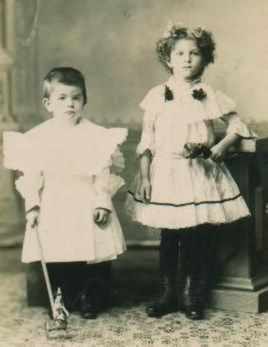
Figure 5.--Special boy dresses, plainer than the girl styles, appeared in the 1890s and were widely sold in the 1900s. Many mothers, however, preferred the frillier styles for girls. It is difficult to tell, but the boy may be wearing a fancy pinafore over his dress.
|
Education
School appear to have been a major factor. Public education developed differently in each European country and America. Schools were a powerful socializing factor. Once a boy was sent to school, his clothing could no longer be determined purely at the whim of the parent. A boy could see how others were being dresses and thus would object to any style which deviated significantly from the norm. Although England was behind other Western European countries in developing a free state education system, by the turn of the century such systems were well established throughout America and Western Europe. This fixed an age of roughly 5 or 6 years old at which most boys had to be breeched. Of course wealthy boy educated at home could be dressed more at their mothers whim. British practices by the turn of the century had diverged significantly from many other countries. The prevalence of boarding schools in England may be one factor. Boys from affluent families were generally sent to boarding preparatory schools at the age of 8 years old. At mid-19th century the age for boarding children varied widely. By about the 1880s practices had become more uniform with the establish of preparatory schools to protect younger children from the rough and tumble of the public school. Thus these children until they were 8 years old were educated at home and likely to be kept in curls and wear very juvenile clothes. At the age to begin school they often would have their hair cut and dress in more clearly boyish clothes. A boy arriving at his prep school in curls or very juvenile clothes would be teased unmercifully by the other boys.
Photography
Most of the available 19th Century photographs of boys wearing dresses are portraits taken in a photographic studio. This is primarily because until the 1890s photographs were taken almost exclusively by professional photographers who took most photographs in their studio. Even in the 1890s only relatively rich people took home photographs. There are a few available photographs taken outside of small and large groups showing boys in dresses. These photographs for the most part date from the 1890s. After the turn of the century, however, informal home snapshots begin to appear in large numbers. This was thanks to George Eastman and his Brownie camera aimed at the amateur photographer. Like the photographs on this site, they show a wide range of ages wearing many different styles of dresses--illustrating the point that there was no hard and set rule as to when boys would have their hair cut and allowed to wear kneepants for the first time.
|
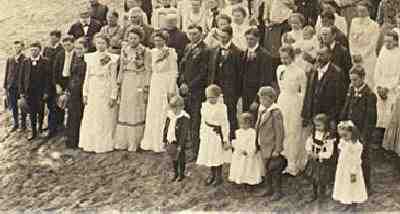
Figure 6.--This picture from around the turn of the century show boys in a wide variety of outfits from adult looking suits to Fauntleroy suits. One of the childrn in a long white dress appears to be a boy with a short hairdo.
|
Other Clothes
Boys in the 20th century began wearing other fashions instead of dresses. Tunic suits were popular alternatives at the century. Boys also began wearing knee pants at an earlier age.
Tunics
After the first decade of the 1900s, boys were increasingly being breeched at earlier ages. Rather than dresses, many mothers in the early 20th Century dresses their boys in tunics in a variety of styles such as Russian tunics or Buster Brown suits. Unlike dresses, these tunics were worn with bloomer style knickers, usually designed to show at the hem of the tunic.
Other clothing styles
Knee pants became increasingly popular for even younger boys after the turn of the century.
Country Patterns
I do not yet have any detailed information on how the fashion of outfitting boys in dresses varied from country to country after the turn of the century. One HBC contributor indicated that European boys wore dresses up to and even after World War I more commonly than in America. He believes that this costume in small villages probably lasted much longer than in the major cities.
Personal Experiences
Alexander Mosley: Britain in the 1940s
Some period movies depict boys in long hair and dresses. Movies of course can vary greatly in historical accuracy. It is likely, however, that those who have gone to the trouble of depicting boys in dresses and long hair, probably exercised considerable attention to detail.
HBC

Navigate the Historic Boys' Clothing Web chronological pages:
[The 1500s]
[The 1600s]
[The 1700s]
[The 1800s]
[The 1840s]
[The 1870s]
[The 1880s]
[The 1890s]
[The 1900s]
[The 1910s]
[The 1920s]
[The 1930s]
[The 1940s]
[The 1950s]
[The 1960s]
Navigate the Historic Boys' Clothing Web dress pages:
[Return to theMain dress chronology page
[Pinafores]
[Sausage curls]
[Smocks>]
[Bodice kilts]
[Kilts]
[Fauntleroy dresses]
[Sailor dresses]
[Fancy dresses]
[Dresses: 16th-18th centuries]
[Dresses: Early-Mid-19th century]
[Dresses: Late-19th century]
[Difficult images]
[Movie dresses]
Navigate the Boys' Historical Clothing Web Site:
[Introduction]
[Activities]
[Biographies]
[Chronology]
[Cloth and textiles]
[Clothing styles]
[Countries]
[Topics]
[Bibliographies]
[Contributions]
[FAQs]
[Glossaries]
[Images]
[Satellite sites]
[Tools]
[Boys' Clothing Home]
Created March 1, 1999
Last updated: 11:31 PM 6/3/2006







